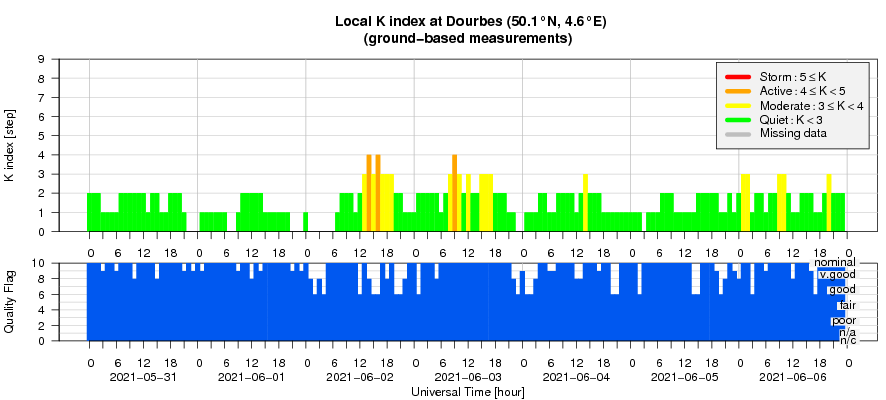- Table of Content
- 1.Quo Vadis ESWC...
- 2.We challenge y...
- 3.June 10 eclips...
- 4.Review of sola...
- 5.PROBA2 Observa...
- 6.The Internatio...
- 7.Radio event
- 8.Review of geom...
- 9.Geomagnetic Ob...
- 10.The SIDC Space...
- 11.Review of iono...
2. We challenge you
3. June 10 eclipse
4. Review of solar activity
5. PROBA2 Observations (31 May 2021 - 6 Jun 2021)
6. The International Sunspot Number by Silso
7. Radio event
8. Review of geomagnetic activity
9. Geomagnetic Observations at Dourbes (31 May 2021 - 6 Jun 2021)
10. The SIDC Space Weather Briefing
11. Review of ionospheric activity (31 May 2021 - 6 Jun 2021)
Quo Vadis ESWC: Registration open!
The Quo Vadis interim board is pleased to announce the opening of the registration to vote on the future organization of the European Space Weather Community. The vote will take place 28-30 June 2021 online and will be opened to registered eligible space weather and climate actors in Europe.
If you are not aware of this initiative please read until the end of this announcement. The future organisation of the European Space Weather and Climate community will be open to everyone whose professional activity is somehow related to the Space Weather and Climate, stakeholders and many others.
Please register to vote at:
https://quovadis.aeronomie.be/index.php/voting/voting-registration-form The deadline for registration is 14 June 2021.
Check your eligibility at:
- https://quovadis.aeronomie.be/index.php/voting/institutional-country-eligibility
- https://quovadis.aeronomie.be/index.php/voting/activity-category-eligibility
Note that the vote is individual and confidential (nobody from the organisation will know who votes what). The voting instructions will be sent in a personalized email after eligibility check.
This initiative is organized by the Interim Board, a group of volunteers from the space weather and space climate community in Europe under the name "Quo Vadis European Space Weather Community?" (short: "Quo Vadis") with the role to coordinate the efforts so that the space weather and space climate European community can
1) Organize itself
2) Elect people to represent it
For more information on the initiative please visit:
https://quovadis.aeronomie.be
Before voting, please also ensure that you familiarise yourself with and participate in the public discussion on the Quo Vadis initiative. To do this please register at https://quovadis.aeronomie.be/index.php/discussion/discussion-registration-form
This discussion follows a white paper https://www.swsc-journal.org/articles/swsc/pdf/2021/01/swsc200098.pdf
The discussion will go on.
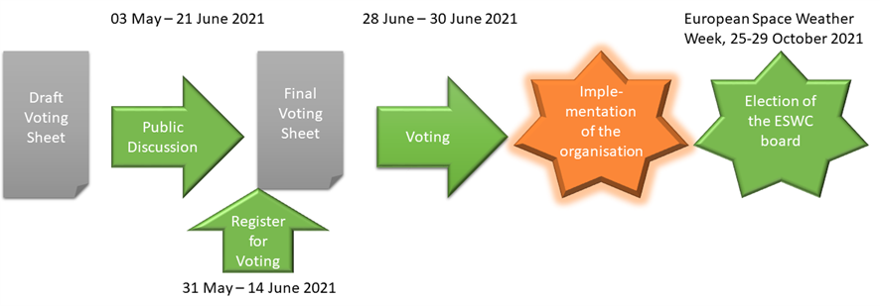
We challenge you
Can you find the hidden messages in the solar eclipse photo taken by SWAP onboard of PROBA2?
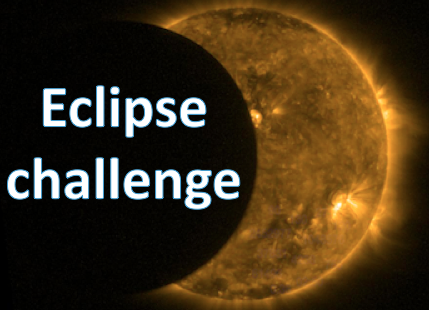
hint: play with (0,0,255)
Source picture, details and questions that need to be answered are on: https://proba2.sidc.be/EclipseChallenge
June 10 eclipse
These young brains will become solar physicists one day. Anyway, the solar spectacle could fascinate old and young.
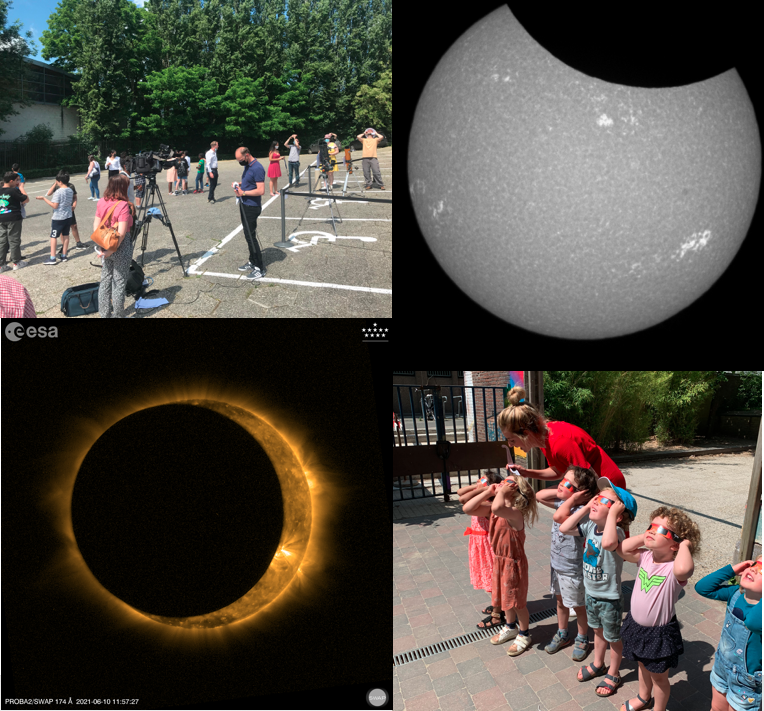
USET: https://wwwbis.sidc.be/uset/Eclipse2021/index.php
SWAP and LYRA: https://proba2.sidc.be/June10Eclipse
Review of solar activity
The solar activity was quiet over the past week, with the GOES X-ray flux remaining below C-level with the exception of one C1.6-class flare peaking at 04:35 UTC on June 01 located in the bipolar sunspot group (Catania sunspot group 1, NOAA 2827).
No Earth directed Coronal Mass Ejection (CME) has been detected in the available coronagraph imagery over the past week. A nice solar dimming was observed on June 05, between 18:57 UTC and 20:15 UTC, near the bipolar sunspot region (Catania sunspot group 2, NOAA-AR 2829) located near longitude -32 degrees and latitude -32 degrees. The associated coronal mass ejection was then observed by SOHO/LASCO at 20:40 UTC on June 05. No Earth-directed component was identified.
The greater than 10 MeV proton flux was at nominal levels over the past week.
The greater than 2 MeV electron flux was below the 1000 pfu threshold and the 24h electron fluence was at normal levels in the last week.
PROBA2 Observations (31 May 2021 - 6 Jun 2021)
Solar Activity
Solar flare activity fluctuated from very low to low during the week.
In order to view the activity of this week in more detail, we suggest to go to the following website from which all the daily (normal and difference) movies can be accessed: https://proba2.oma.be/ssa
This page also lists the recorded flaring events.
A weekly overview movie can be found here (SWAP week 584): https://proba2.sidc.be/swap/data/mpg/movies/weekly_movies/weekly_movie_2021_05_31.mp4
Details about some of this week's events can be found further below.
If any of the linked movies are unavailable they can be found in the P2SC movie repository here: https://proba2.oma.be/swap/data/mpg/movies/
Tuesday Jun 01
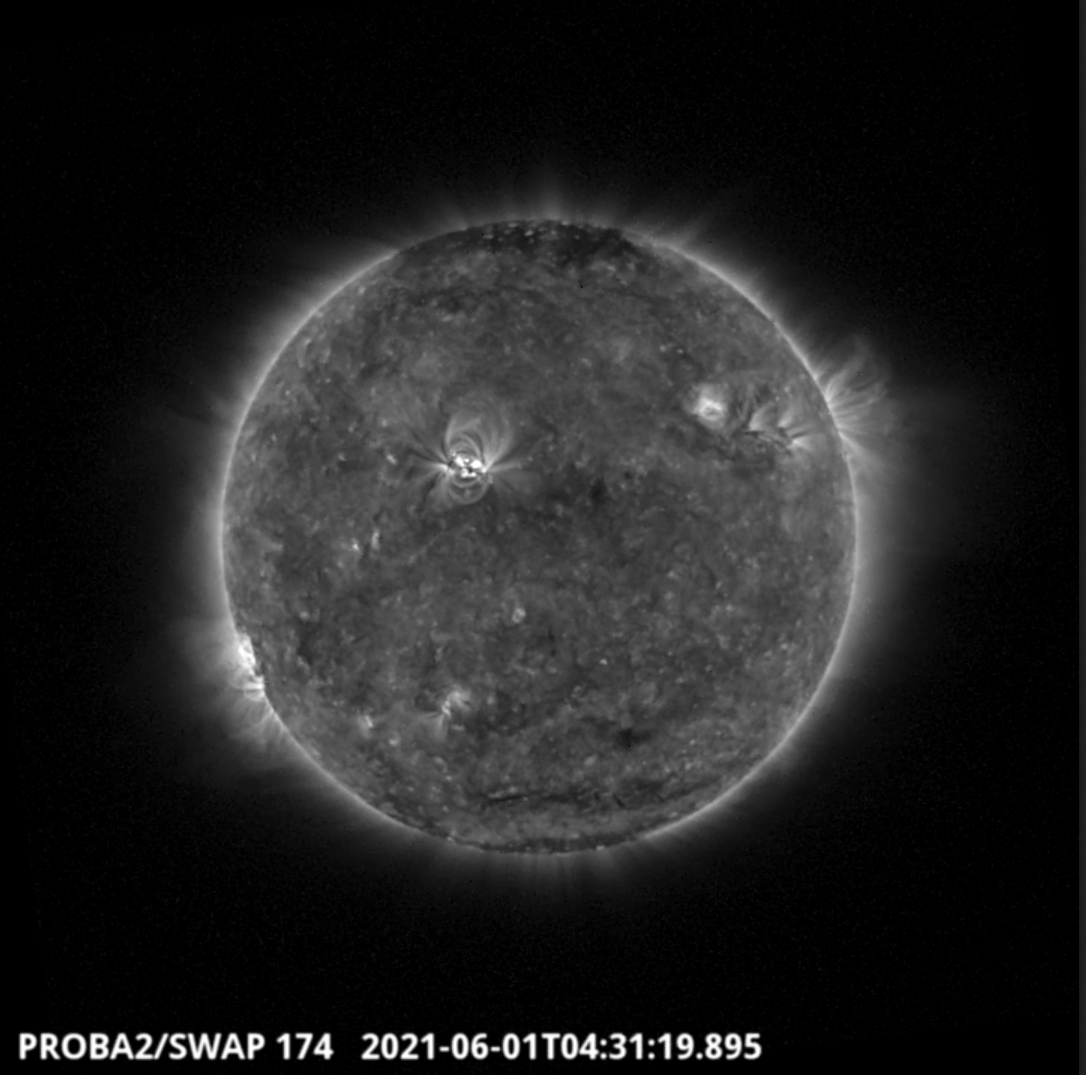
The largest flare of the week, a C1.6 flare, was observed by SWAP and LYRA. The flare and associated eruption is visible in the northern hemisphere of the solar disk on 2021-Jun-01, as shown in the SWAP image above taken at 04:31 UT.
Find a movie of the entire day here (SWAP movie): https://proba2.sidc.be/swap/movies/20210601_swap_movie.mp4
The International Sunspot Number by Silso
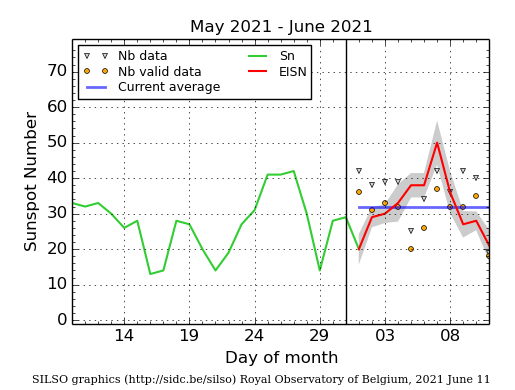
The daily Estimated International Sunspot Number (EISN, red curve with shaded error) derived by a simplified method from real-time data from the worldwide SILSO network. It extends the official Sunspot Number from the full processing of the preceding month (green line), a few days more than one solar rotation. The horizontal blue line shows the current monthly average. The yellow dots gives the number of stations that provided valid data. Valid data are used to calculate the EISN. The triangle gives the number of stations providing data. When a triangle and a yellow dot coincide, it means that all the data is used to calculate the EISN of that day.
Radio event
The HSRS and ARCAS spectrometers operated from the Human Radioastronomy Station observed the following radio event:
Date: 9 June 2021, 11:55 - 12:20
Radio event: Type II burst
Context: B4.5 flare in NOAA AR 2827, prominence eruption on limb
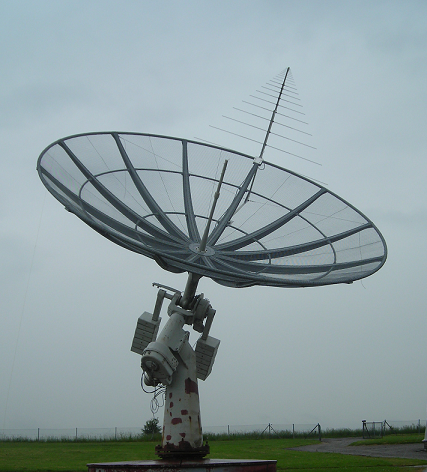
Check the quicklook and the complete list of radio events of solar cycle 25: http://sidc.be/humain/hsrs_events_cycle_25.php
Review of geomagnetic activity
The solar wind observed by ACE and DSCOVR, was slow during the major part of the week. The solar wind speed ranged between 280 km/s to 480 km/s. On June 02 at 12:20 UT, a shock in the solar wind was observed. The speed jumped from 289 km/s to 325 km/s and the interplanetary magnetic field magnitude from 3 nT to 6 nT. The origin of these enhanced solar wind conditions was associated with the arrival of the coronal mass ejection from May 28.
The geomagnetic conditions were mostly from quiet to unsettle over the past week. It was active for a short period (max K-Dourbes = 4, and max NOAA-Kp = 3) due to the solar wind shock observed at 12:20 UT on June 02.
The SIDC Space Weather Briefing
The Space Weather Briefing presented by the forecaster on duty from May 30 to June 6. It reflects in images and graphs what is written in the Solar and Geomagnetic Activity report.

A pdf-version: https://www.stce.be/briefings/20210607_SWbriefing.pdf
The movie: https://www.stce.be/briefings/20210607_SWbriefing.m4v
Review of ionospheric activity (31 May 2021 - 6 Jun 2021)
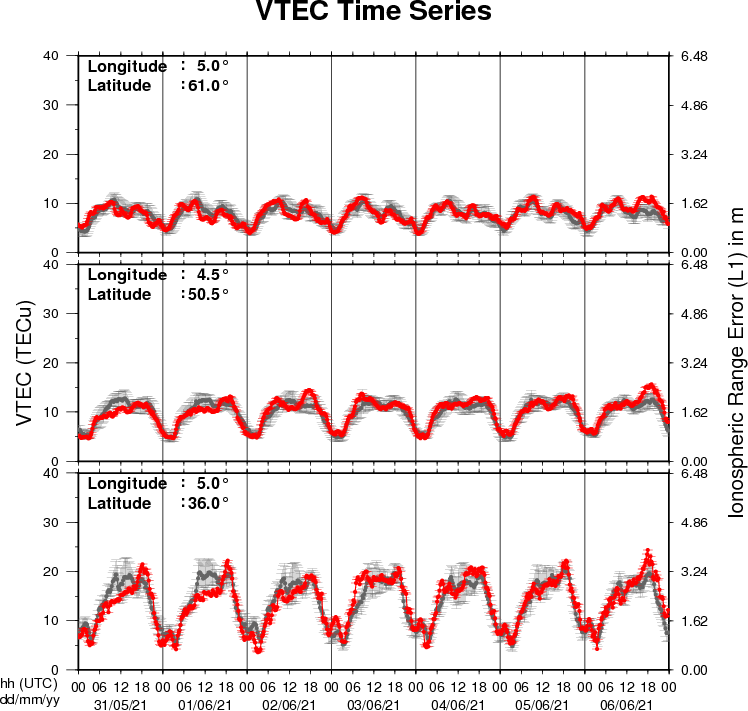
The figure shows the time evolution of the Vertical Total Electron Content (VTEC) (in red) during the last week at three locations:
a) in the northern part of Europe(N61°, 5°E)
b) above Brussels(N50.5°, 4.5°E)
c) in the southern part of Europe(N36°, 5°E)
This figure also shows (in grey) the normal ionospheric behaviour expected based on the median VTEC from the 15 previous days.
The VTEC is expressed in TECu (with TECu=10^16 electrons per square meter) and is directly related to the signal propagation delay due to the ionosphere (in figure: delay on GPS L1 frequency).
The Sun's radiation ionizes the Earth's upper atmosphere, the ionosphere, located from about 60km to 1000km above the Earth's surface.The ionization process in the ionosphere produces ions and free electrons. These electrons perturb the propagation of the GNSS (Global Navigation Satellite System) signals by inducing a so-called ionospheric delay.
See http://stce.be/newsletter/GNSS_final.pdf for some more explanations ; for detailed information, see http://gnss.be/ionosphere_tutorial.php
